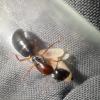Sounds good.
- Formiculture.com
- Forums
- Gallery
- Members
- Member Map
- Chat

Sounds good.
Update 7-9-2015
The one remaining queen is still poking around in its test tube. It lays an egg or two every once and a while, but just eats them or lets them die. I've been feeding it byFormica Formula 100. I don't know if it's eating it or not, but it's still alive so who knows.
Update 7-27-2015
This queen is still alive amazingly. I moved her into a dirt box to see if that might help her produce some workers.
How do you make these ant boxes?
Currently Keeping:
Trachymyrmex septentrionalis
Pheidole pilifera
Forelius sp. (Monogynous, bicolored) "Midwestern Forelius"
Crematogaster cerasi
Pheidole bicarinata
Aphaenogaster rudis
Camponotus chromaiodes
Formica sp. (microgena species)
Nylanderia cf. arenivega
Update 8-3-2015
The last remaining queen died.
I got to thinking about this the other day. This species stuck out as incredibly unique, and rather amazing.
I wonder if these queens would do better boosting them with brood from another ant. Doing the same species would be really hard, just because who knows where they could nest. Either that, or get lucky and find some workers to give her. This species seems like it would do great if got help with initial workers, then starting by themselves. I'm not sure what species could be boosted for them, but I imagine another subterranean based species. These seem to do horribly by themselves. However, I noticed the ones in the test tube seemed to do way better, until you put them in dirt boxes. They seemed to do terrible in dirt. Heck, even trying peat moss might work better instead...plus peat moss would provide a lot of nutrients. I'm pretty big on using peat moss these days for a lot of my colonies. Peat moss holds together well, holds moisture well and all my ants (even Pogonomyrmex) love to dig in it.
No idea if you'll find them again or not though, but if they are found in the area you got them, I imagine you could try again around same time. I just figured I'd post some ideas, if you tried again next year. That way maybe people can discuss different things to try to raise this species.
I'm planning to try finding them again.
maybe the boxes are bad for them? the ones that moved into the boxes all died
Owner of :
7 Founding Brachymyrmex Patagonicus queens
The ones in the test tube as I posted, did seem to do better. But they kept eating their eggs on him. I doubt Drew disturbed them, unless they are just an extremely sensitive ant (I have noticed subterranean ants tend to be a bit more sensitive to disturbances. At least from my experience). I think peat moss is still worth trying for at least a couple/few of them.
I have a feeling these would be VERY hard to get a colony going. No one even really seems to know if they need food to start a colony or not. Which the lack of information is just because they are a highly unknown ant for the most part. But, a tiny drop of honey could help a lot. Most ants love honey, even when they are a fully claustral species.
It be cool to see a colony of these get going though, I imagine they would be a really rewarding ant and fun to keep.
They kind of remind me of Army ant queens in how they look. I wonder if they could be similar in behavior, but strictly underground instead of raiding on the surface.
There really weren't enough of them to draw any real conclusions.
Hi there! I went on a 6 month or so hiatus, in part due, and in part cause of the death of my colonies.
However, I went back to the Sierras, and restarted my collection, which is now as follows:
Aphaenogaster uinta, Camponotus vicinus, Camponotus modoc, Formica cf. aserva, Formica cf. micropthalma, Formica cf. manni, Formica subpolita, Formica cf. subaenescens, Lasius americanus, Manica invidia, Pogonomyrmex salinus, Pogonomyrmex sp. 1, Solenopsis validiuscula, & Solenopsis sp. 3 (new Sierra variant).
Ant Keeping →
Ant Keeping Journals →
cooIboyJ's Nylanderia vividula journalStarted by cooIboyJ , Sep 6 2025 |
|

|
||
Ant Keeping →
Ant Keeping Journals →
Ants_Dakota's Camponotus sp. JournalStarted by Ants_Dakota , Jul 13 2025 |
|

|
||
Ant Keeping →
Ant Keeping Journals →
Strickys Formica JournalStarted by stricky_ants , Jun 21 2025 |
|

|
||
Ant Keeping →
Ant Keeping Journals →
AntTx's Camponotus sansabeanus JournalStarted by AntsTx , Jun 17 2025 |
|

|
||
Ant Keeping →
Ant Keeping Journals →
The Bark Battalion (Liometopum occidentale)Started by AntsGodzilla , Jun 3 2025 |
|

|
0 members, 1 guests, 0 anonymous users